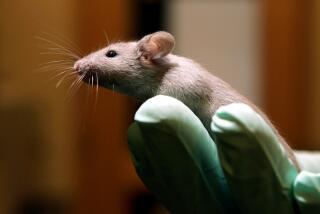Scientists explain how stem cells and ‘bad luck’ cause cancer
- Share via
Why are some types of cancer so much more common than others? Sometimes it’s due to faulty genes inherited from one’s parents and sometimes to behaviors like smoking a pack of cigarettes every day. But in most cases, it comes down to something else – stem cells.
This is the intriguing argument made by a pair of researchers from Johns Hopkins University. In a study published Friday in the journal Science, they found a very high correlation between the differences in risk for 31 kinds of cancer and the frequency with which different types of stem cells made copies of themselves.
Just how strong was this link? On a scale that goes from 0 (absolutely no correlation) to 1 (exact correlation), biostatistician Cristian Tomasetti and cancer geneticist Bert Vogelstein calculated that it was at least a 0.8. When it comes to cancer, that’s high.
“No other environmental or inherited factors are known to be correlated in this way across tumor types,” Tomasetti and Vogelstein wrote.
Researchers have long recognized that when cells copy themselves, they sometimes make small errors in the billions of chemical letters that make up their DNA. Many of these mistakes are inconsequential, but others can cause cells to grow out of control. That is the beginning of cancer.
The odds of making a copying mistake are believed to be the same for all cells. But some kinds of cells copy themselves much more often than others. Tomasetti and Vogelstein hypothesized that the more frequently a type of cell made copies of itself, the greater the odds that it would develop cancer.
The pair focused on stem cells because of their outsized influence in the body. Stem cells can grow into many kinds of specialized cells, so if they contain damaged DNA, those mistakes can spread quickly.
The researchers combed through the scientific literature and found studies that described the frequency of stem cell division for 31 different tissue types. Then they used data from the National Cancer Institute’s Surveillance, Epidemiology and End Results database to assess the lifetime cancer risk for each of those tissue types. When they plotted the total number of stem cell divisions against the lifetime cancer risk for each tissue, the result was 31 points clustered pretty tightly along a line.
To put this notion in concrete terms, consider the skin. The outermost layer of the skin is the epidermis, and the innermost layer of the epidermis contains a few types of cells. Basal epidermal cells are the ones that copy themselves frequently, with new cells pushing older ones to the skin’s surface. Melanocytes are charged with making melanin, the pigment that protects the skin from the sun’s damaging ultraviolet rays.
When sunlight hits bare skin, both basal epidermal cells and melanocytes get the same exposure to UV. But basal cell carcinoma is far more common than melanoma – about 2.8 million Americans are diagnosed with basal cell carcinoma each year, compared with roughly 76,000 new cases of melanoma, according to the Skin Cancer Foundation. A major reason for this discrepancy, Tomasetti and Vogelstein wrote, is that epidermal stem cells divide once every 48 days, while melanocytes divide only once every 147 days.
Overall, the researchers calculated that 65% of the variation in the risk of different types of cancer can be explained by how often stem cells copy themselves.
The pair also determined that some cancers – including lung cancer in smokers and hepatocellular carcinoma in patients with hepatitis C – occur more frequently than their stem cell replication rate would suggest. In these cases, getting people to change their behavior can prevent many cases of cancer, Tomasetti and Vogelstein wrote.
But for most of the tumor types they analyzed, a cancer diagnosis comes down to little more than “bad luck,” they wrote. There’s not much that patients can do to prevent these cancers, they added, so doctors should focus on finding them early when they are more susceptible to treatment.
For more cutting-edge science, follow me on Twitter @LATkarenkaplan and “like” Los Angeles Times Science & Health on Facebook.





